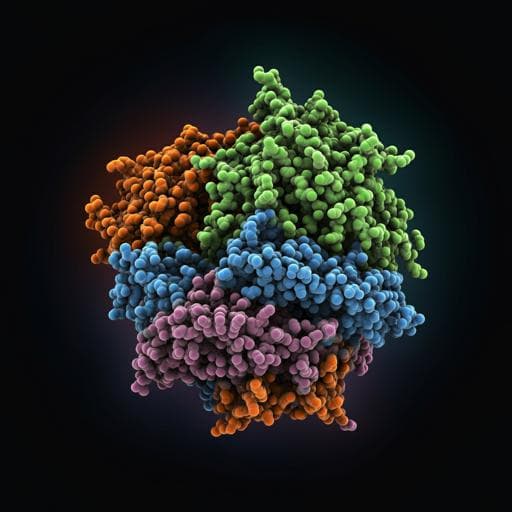
Food Science and Technology
Reference proteomes of five wheat species as starting point for future design of cultivars with lower allergenic potential
M. Afzal, M. Sielaff, et al.
This groundbreaking study explored the flour proteome of five wheat species, revealing significant differences in protein expression linked to product quality and allergenic potential. Notably, einkorn wheat exhibited lower levels of allergens compared to common wheat. Conducted by researchers Muhammad Afzal, Malte Sielaff, Ute Distler, Detlef Schuppan, Stefan Tenzer, and C. Friedrich H. Longin, these findings can significantly aid in breeding healthier wheat cultivars.
~3 min • Beginner • English
Introduction
Wheat is a globally important staple crop providing a substantial portion of dietary protein and micronutrients. Modern common wheat and durum dominate production, while ancient species such as spelt, emmer, and einkorn are cultivated on smaller scales. Wheat proteins determine processing quality but also trigger inflammatory conditions including celiac disease, IgE-mediated wheat allergy, and non-celiac wheat sensitivity. Specific gluten epitopes drive celiac disease, and alpha-amylase/trypsin inhibitors (ATIs) activate innate immunity via TLR4 and can contribute to inflammation; several other protein families (serpins, LTPs, β-amylases, ATIs, some gluten proteins) can elicit allergic reactions. Prior comparisons across wheat species were typically limited to specific protein families or a small number of cultivars. The study aims to generate high-resolution reference proteomes for five wheat species and quantify the effects of species, cultivar, and environment on protein abundance, with a focus on proteins related to quality, starch metabolism, stress response, and potential human allergenicity. The overarching hypothesis is that species- and genotype-driven proteomic differences, some with high heritability, can be leveraged to develop cultivars with lower allergenic potential and improved nutritional profiles.
Literature Review
Earlier work largely targeted individual protein families such as gluten proteins or ATIs, or compared the immunogenic potential of ATIs between common wheat and einkorn. Advances in LC-MS-based proteomics now allow quantification of thousands of proteins rapidly and have been applied to compare proteomes of common wheat, spelt, and rye, revealing differential expression even between hexaploid species. A recent study of 150 common wheat cultivars demonstrated substantial environmental and cultivar effects on protein expression. However, a comprehensive comparison of flour proteomes across common wheat, spelt, durum, emmer, and einkorn using modern high-coverage proteomics had not been performed. This study addresses that gap by profiling 10 cultivars per species across three environments.
Methodology
Study design and plant material: Ten cultivars from each of five wheat species (common wheat, spelt, durum, emmer, einkorn) representative of the German market and advanced breeding lines were grown as winter crops in 2018/2019 at three diverse locations in Germany/Austria. Trials for each species were run in separate but adjacent un-replicated field designs randomized per species and location. Agronomic management followed intensive conventional practices with species-specific nitrogen fertilization targets (common wheat 180, durum 180, spelt 160, emmer 60, einkorn 60 kg N/ha including soil Nmin). Einkorn did not receive fungicides due to high field resistance. Plot size was 5 m². Hulled species were dehulled and all samples cleaned post-harvest.
Sample preparation and proteomics: Whole-grain flour (20 mg) per sample was extracted in urea/thiourea/CHAPS/DTT buffer. Average protein concentrations were determined on species-specific mixtures. Proteins (30 µg) underwent FASP-based cleanup and on-filter tryptic digestion (trypsin 1:50 w/w, overnight 37 °C). Peptides were desalted (C18), lyophilized, and reconstituted.
LC-MS/MS acquisition: Peptides (1.5 µL) were separated by microflow nanoACQUITY UPLC on a 250 mm × 300 µm HSS-T3 column over 60 min at 5 µL/min and analyzed on a Waters SYNAPT G2-S using ion mobility-enhanced data-independent acquisition (UDMSE). Each biological sample (per location) was run once (one technical replicate), prioritizing multiple environments to capture environmental variance.
Data processing and LFQ: Raw data were processed in PLGS v3.0.2 and searched against a Triticum UniProtKB (release 2020_05) database containing reference proteomes of T. turgidum ssp. durum (51%), T. aestivum ssp. aestivum (38%), and T. urartu (9%) plus 171 contaminants. Trypsin specificity with up to two missed cleavages (for search), fixed carbamidomethyl (C), variable Met oxidation. FDR 1% at peptide/protein levels using reverse decoys. Quantification used ISOQuant v1.8 with peptides without missed cleavages, length ≥7 aa, PLGS score ≥6, no variable modifications, 1% FDR at dataset level. Protein abundances were estimated via TOP3 (average of three most intense unique peptides), with redistribution of shared peptides based on unique peptide ratios. Abundances were normalized across runs and expressed as relative amounts (ppm of total protein).
Functional annotation: Proteins were annotated using Blast2GO v5.2.5 (BLASTp against NCBI nr, InterProScan) to assign GO terms.
Phenotypic/statistical analysis: For each species separately, a linear mixed model was used: y_ik = μ + v_i + env_k + e_ik, estimating variance components via REML (ASReml 3.0), with likelihood ratio tests for significance. Across-environment means (BLUEs) assumed fixed cultivar effects. Heritability (h²) was computed per Piepho & Möhring as 1 − σ²_g/2σ²_g (mean variance of predictor differences vs genotypic variance). Pairwise species comparisons used Student’s t-test at α=0.05; Levene’s test assessed homoscedasticity and Welch’s t-test was applied if variances differed. Volcano plots highlighted proteins with p<0.05 and |log2 fold change| ≥3. Hierarchical clustering used scaled data, Euclidean distance, Ward’s method.
Allergen identification: Potential allergens were compiled using the curated list of seed-borne wheat allergens (AllFam and AllergenOnline), the Allergome database (mapping via UniProt accessions), and extended by annotating amylase/trypsin inhibitors (ATIs) from UniProt. The list of ATIs and allergen mappings are provided in Supplementary Table 4. Proteomics data were deposited to PRIDE (PXD028676).
Key Findings
- Coverage and identification: Across 150 flour samples (5 species × 10 cultivars × 3 environments), 17,277 peptide sequences and 2,896 proteins were identified. Per species, proteins identified were: common wheat 2,706; spelt 2,705; durum 2,671; emmer 2,687; einkorn 2,540.
- Environmental and genetic effects: Many proteins were environment-sensitive. In einkorn, of 2,540 identified, 1,940 were stably present across all environments in at least one cultivar; mean heritability across proteins was 0.24, with 380 proteins h²>0.5. Applying stringent filters to select proteins mainly driven by genetics yielded 845 (common wheat), 611 (spelt), 863 (durum), 262 (emmer), and 296 (einkorn) proteins, spanning key families (glutenins/gliadins, starch enzymes, inhibitors, serpins, LTPs, stress-response proteins).
- Species separation: Hierarchical clustering using 2,774 proteins clearly separated the 50 cultivars into five species-specific clusters, reflecting ploidy-related genetic distances (hexaploids clustered together; tetraploids clustered together).
- Differential expression between species: 1,474 proteins were shared across all five species, yet in any pairwise species comparison >50% of shared proteins showed significantly different abundance. Examples: 52% differed between spelt and common wheat; 78% differed between einkorn and common wheat. A total of 254 proteins exhibited large differences (|log2FC| ≥3, ≈8-fold) and p<0.05, notably in baking quality, starch metabolism, allergenicity, and stress-response families.
- Allergenicity profiles: Total abundance of potential allergenic proteins scaled with ploidy: similar in hexaploid common wheat and spelt, approximately two-fold lower in tetraploid durum and emmer, and 5.4-fold lower in diploid einkorn. ATI abundance was markedly reduced in einkorn: 7.2-fold lower vs common wheat, 7.3-fold vs spelt, 5.2-fold vs durum, and 4.7-fold vs emmer. In einkorn, ATIs were mainly CMX1/CMX3 types, not listed as seed-borne wheat allergens and not known to inhibit amylase activity; hexaploids predominantly expressed 0.19, CM1, CM2, CM3, CM16; tetraploids mainly 0.53, CM3, CM16. Many potential allergens showed h²>0.5 in common wheat, spelt, and durum, indicating scope for breeding to reduce allergen loads.
- Quality and nutritional context: Despite lower potential allergen loads, einkorn, spelt, and emmer exhibited slightly higher grain protein content than common wheat. The study provides a comprehensive, high-resolution reference proteome enabling targeted breeding and monitoring of proteins affecting product quality, stress tolerance, and potential human allergenicity.
Discussion
The study demonstrates that wheat species possess distinct, species-specific proteomic profiles that align with genetic ploidy and can be captured robustly across multiple environments. The substantial proportion of proteins differing significantly between species, including those central to baking quality, starch metabolism, stress response, and known or potential allergens, directly addresses the objective of understanding how species and genetics shape the flour proteome. Identification of proteins with higher heritability indicates that cultivar selection and breeding can modulate the abundance of key proteins relatively independently of environmental variation.
From a health perspective, the marked reduction in total potential allergens and particularly ATIs in einkorn suggests a path to developing cultivars and food products with lower allergenic potential. The differential ATI repertoire in einkorn (dominance of CMX1/CMX3) may translate to reduced innate immune activation compared to hexaploid wheats. Because many allergenic proteins also showed meaningful heritability and variation among cultivars, the findings provide actionable targets for selecting lower-allergen genotypes and for designing monitoring assays. However, clinical outcomes must be validated; the reference proteomes enable the design of standardized, representative test diets for controlled trials.
Practically, the separation of species by proteome and the catalog of high-heritability proteins provide a resource for breeding programs and the wheat supply chain to tailor wheat types for specific quality and health goals, provided rapid test methods are developed for routine screening.
Conclusion
This work delivers high-resolution reference proteomes for five wheat species across 10 cultivars and three environments, revealing extensive species- and genotype-driven differences in protein abundance, with many proteins displaying sufficient heritability to be breeding targets. Notably, einkorn exhibits substantially reduced total potential allergens (≈5.4-fold) and ATIs (≈7.2-fold vs common wheat), while maintaining favorable protein content and valuable micronutrients, positioning it as a promising candidate for lower-allergen wheat products and for cultivation in marginal environments.
Future research should: (i) develop rapid, scalable assays for key allergenic and quality-related proteins to support breeding and supply-chain decisions; (ii) conduct well-controlled clinical trials using genotypes with defined low allergen/ATI content to validate health benefits; (iii) assess effects of processing (e.g., sourdough fermentation) on allergen abundance/activity; (iv) expand reference databases for underrepresented species to reduce identification bias; and (v) integrate multi-omics with breeding to optimize both agronomic performance and health-related proteome traits.
Limitations
- Database bias: Lack of comprehensive reference proteomes for spelt, emmer, and einkorn may have limited detection of species-unique proteins and could accentuate observed inter-species differences.
- Environmental influence: Protein abundances were strongly environment-dependent, necessitating multi-location trials; some proteins showed presence/absence driven by environment alone.
- Replication: Only one technical LC-MS/MS replicate per sample was acquired, trading off technical replication for broader environmental coverage, which may limit precision of technical variance estimates.
- Trial design and management: Species were grown in separate but adjacent un-replicated field trials with species-specific nitrogen regimes and fungicide use (no fungicide in einkorn), potentially introducing management-related differences beyond genetics.
- Clinical generalizability: Proteomic indicators of allergenic potential require validation in controlled clinical studies before inferencing health outcomes.
Related Publications
Explore these studies to deepen your understanding of the subject.







